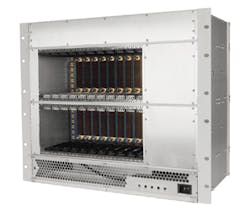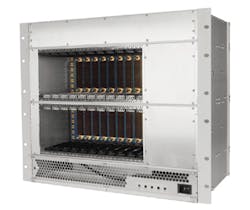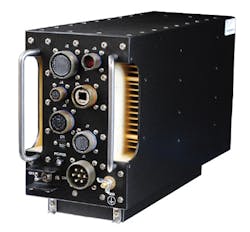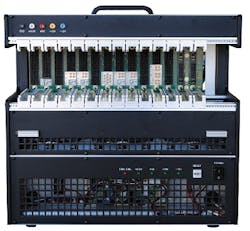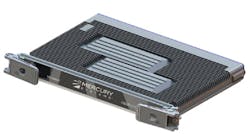Backplanes and chassis for military electronics
Databuses today revolve around 3U and 6U VPX, but many applications still rely on VME and 3U CompactPCI, while demanding performance is giving rise to a variety of innovative air- and liquid-cooling approaches.
Here are a few things you can count on from those who specify defense electronics: They want it small; they want it powerful; they want it interoperable; and they want it to be cost-effective. These needs drive aerospace and defense electronics designers to reduce size, weight, and power consumption (SWaP); provide increased processing power; and increase their reliance on open-systems standards.
How this shakes out for the embedded computing industry is the increasing popularity of databus and backplane designs that adhere to 3U and 6U VITA VPX architectures. VPX, as it encompasses its many different versions, is perhaps today's biggest trend when it comes to backplanes and databuses in military and aerospace electronics.
The 9U RiCool chassis platform from Pixus Technologies offers 392 cubic feet per minute of airflow. It offers 32 OpenVPX backplane slots in the 3U size and up to 16 slots accommodating 6U cards.
Design trends leading to VPX architectures also require innovative cooling and thermal management to accommodate current and future powerful digital processors and analog RF and microwave components; government- and industry-backed open-systems standards initiatives to enhance popularity and drive down costs; new approaches to squeezing the most capability possible into small electronics enclosures; and overall industry consensus on the best paths to the future.
At the same time, there's still a lot of interest in legacy backplane and databus architectures like VME and 3U CompactPCI for technology insertion and systems upgrades in existing applications, as well as for new applications with relatively modest demands on processing power.
These trends are requiring from systems designers and component suppliers a mix of technology innovation, good sense, and a willingness to work together in standards organizations to level the playing field and create broad opportunities for design wins for new platforms and legacy systems.
The rise of VPX
"Everything is pushing toward OpenVPX, and that could be much bigger than the first wave," says Ivan Straznicky, chief technology officer of advanced packaging at the Curtiss-Wright Corp. Defense Solutions Division in Ashburn, Va.
"We are seeing growth in our demand for VPX," says Ken Grob, director of embedded technologies at Elma Electronic Inc., an international company based in Wetzikon, Switzerland. "That takes us to the types of VPX backplanes being requested. We are seeing more demand for 3U than we are for 6U VPX. The applications requiring VPX are high-performance embedded computing (HPEC) products."
Where it breaks down between 6U and 3U VPX depends on the application, says Grob, who is based in Horsham, Pa. The 6U VPX circuit board is roughly twice the size of the 3U board, and typically is packaged in a system in an air transport rack (ATR)-type enclosure. Elma is seeing demand for 6U VPX at roughly 30 or 40 percent of the company's demand for 3U VPX, Grob says.
"We also are doing 6U VPX designs, and it is significant," Grob says. "6U is more than niche; it needs to be conduction-cooled, or needs to be in an ATR. But if the computing needs to be in a pod, or in communications and radios, those things fit well on 3U VPX. A variety of sensor-based platforms are leveraging the 3U VPX architecture."
Typically, the most demanding applications, in which small size isn't necessarily a top priority, are opting for 6U VPX. "If it is sensor-related, and you need a lot of I/O, the I/O requirement drives you out of a 3U board," Grob says. "Or if you need the processing requirements for high-performance FPGAs [field-programmable gate arrays], some duality that requires dual-FMCs for A/D converters, or high-performance Xeon processors that might not fit on 3U."
This year Elma got requests for 6U backplanes with power densities as high as 3,000 watts for redundant systems or symmetrical architectures, Grob says. That level of thermal management simply would not be possible in a 3U system.
One attractive element of 6U and 3U VPX is its ability to accommodate safety-certifiable systems for commercial and military avionics, says Curtiss-Wright's Straznicky. "Safety certification is a trend in aerospace and defense, and because of this trend we are seeing some influence from commercial avionics, in particular on the small-form-factor VPX side."
Ease of design and the potential for interoperability also are benefits of using VPX, says R.J. McLaren, systems product manager at Kontron America in Mira Mesa, Calif. "A lot of customers in pure defense want to have plug-in cards in a backplane, and everybody is going with the VPX style."
This rugged 3U VPX air conduction-cooled chassis from Elma is for avionics, land vehicles, and other military SWaP-constrained applications.
The stronger the need for computer power, the more likely the systems integrator will specify VPX, McLaren says. "Where you might want to move to VPX is if you want more real-time processing capability. You could upgrade your low-speed card to a mezzanine card and keep the same enclosure size."
Yet one of the most compelling reasons to choose VPX is its capacity for growth. "You can add analytical capability," McLaren says. "People are looking at VPX for its growth potential and to increase processing and analytical capability inside existing platforms."
Industry experts admit, however, that not all military embedded computing applications call for VPX because of the technology's relative complexity. The VPX standard offers many different profiles, and the process of sifting through them in search of just the right design approach can be a big challenge.
"There are so many different designs in VPX; every backplane is custom," says Doug Patterson, vice president of marketing and business development at Aitech Defense Systems Inc. in Chatsworth, Calif. "There are three or four backplane configurations with how the main PCIbus works. There are code numbers associated with every single backplane configuration of a card. You have to decipher the standard, and it is a pain for the customer base to get interoperability because there are so many variables in the standard."
It is for these and similar reasons that some systems designers are taking a second look at legacy embedded computing backplane technologies like VME and CompactPCI - especially when it comes to ease of use.
The enduring legacy of VME
With the growing popularity of VPX, there are plenty of embedded computing engineers who are surprised that VME survives as a viable option.
"We thought VPX would be the death knell for VME, but that has not been the case," says Curtiss-Wright's Straznicky. "VME is still alive and kicking. If a prime or end-user has a requirement to upgrade functionality, and they can still get by with VME, then you just take out the computing blade and put in another VME blade. Those applications continue to pop up with a high number of programs. We and others continue to introduce new VME products, and that is testimony that our customers still want to use it."
When - and if - there will be an end of VME in military and aerospace electronics designs is anyone's guess.
"VME has not gone away by any means, even though more programs are asking for VPX," says Kontron's McLaren. "If it isn't broke, then don't fix it. If you have a single-processor and low-speed signaling I/O cards, and your design is for a use case, then there is not a compelling reason to go with VPX. There are plenty of systems out there where VME still makes sense."
Ease of use remains one of the most attractive features of VME. While VPX requires systems designers to navigate through many different profiles and technologies, "the big question in VME is how many slots do you want," says Aitech's Patterson. "At the high end, with high speed FPGAs in vision systems is where VME falls short."
While VME may fall short in complex digital signal processing, "not every application requires gigabits per lane on a backplane," Patterson continues. "If you are controlling a mirror in a targeting platform, you don't need VPX. If it is a simple control system, then VME works fine, and so does Compact PCI."
Patterson says Aitech is still getting VME design wins at the rate of a couple a month. "Machine control and process control is the sweet spot for VME and 3U Compact PCI. Fire control for missile systems? VME works just fine."
Patterson says he sees the military embedded computing market broken out to about 50 percent VPX, and 50 percent VME and 3U CompactPCI. "We have introduced the fastest Intel processors and Freescale PowerPC on VME, and they are doing fine. Why would Aitech make another VME card if the market is dead? The answer is people want to buy it; it is much easier to work with, and is less complex."
As with many legacy technologies, however, users VME and 3U CompactPCI must contend with obsolescence issues. If there will be an end to VME in the future, it may be due to the lack of VME interface chips, which are rarely manufactured today.
"VMEBus interface chips, they are gone," Patterson says. "We found them, we bought them, and they're gone. We made a huge investment and bought the parts. CompactPCI chips have the same problem."
Kontron's McLaren, however, says finding VME interface chips can be a challenge, but one he can deal with. "There are bridge chips we use for legacy devices," he says. "It's not as easy as it used to be to find them, but we stay on top of that."
Cooling and thermal management
For high-performance embedded computing involving 6U or 3U VPX, cooling and thermal management almost always is an issue. To get the heat out, companies are using industry-standard cooling techniques that involve high-performance air cooling, liquid cooling, or a hybrid of both.
Curtiss-Wright is using VITA 48.8-standard air flow through cooling to remove heat from 6U VPX systems running as much as 250 watts. Air-flow-through retains sealing of on-board components to reduce the threat of contamination, while using high-velocity blown air to remove heat individually from each board.
The Elma 3U OpenVPX 12-slot CMOSS backplane supports the defense industry's hardware and software convergence initiatives for modular architecture. It is an integration platform for modules addressing the military's C4ISR Modular Open Suite of Standards (CMOSS).
Air-flow-through cooling is an alternative to traditional conduction cooling that removes heat from boards through board wedge locks and out to the edge of the electronics enclosure. It can provide adequate cooling to high-performance systems that only a short time ago would require liquid cooling.
Moreover, liquid flow through cooling opens up new possibilities in using non-metallic chassis materials to save on size and weight. "It gives us the ability to use materials other than metals, like composites and polymeric materials," says Curtiss-Wright's Straznicky. "That is an interesting change from what we've seen in the past."
Air-flow-through doesn't solve all thermal-management problems, however. "Once you get into 300 watts or more on a 6U blade, you really need to consider liquid-flow-through cooling," Straznicky says.
Engineers at Mercury Systems are using a hybrid approach that blends air and liquid flow through cooling for applications that may not have continual access to air or liquid on a platform. This approach, which Mercury calls air flow by, "offers the same cooling as with liquid-flow-through, but also has baked-in air-flow-through," says John Bratton, product and solutions marketing manager at Mercury Systems in Andover, Mass.
For many implementations of VPX, "cooling really drives the architecture," Bratton says. Mercury's air-flow-through thermal-management approach is creating "a redundant and more-robust cooling capability," Bratton says. "It can air cool or liquid cool, from hot on the ground to operating at altitude; it can cool with the fuel running or not."
With its ability to cool with liquid or air, Mercury's air-flow-through offers more cooling in a smaller space "so you can put more cards in a system," Bratton says. This design "is flying today," although he declines to name the specific application.
Not only can this approach cool high-performance digital electronics, but also has the potential to cool much-hotter RF and microwave components, which is a particular benefit to Mercury, which is blending digital and RF and microwave processing in a variety of electronic warfare and radar systems. "It offers a solution across the sensor-processing chain, and cab become very small, rugged, and application-specific like the electronics at the front of a missile," Bratton says.
Military standards initiatives
One of the most-watched military standards initiatives where embedded computing is concerned is the C4ISR/EW Modular Open Suite of Standards (CMOSS), which is part of the U.S. Army Communications-Electronics Research, Development and Engineering Center (CERDEC) C4ISR/EW Hardware/Software Convergence project.
Mercury Systems uses liquid-flow-by technology in this VPX embedded computing board, which uses a hybrid approach using air and liquid for cooling.
It seeks to create a converged architecture that provides open interfaces to enable rapid insertion of new capabilities, interoperability, and a reduced SWaP footprint. It seeks to enable sharing of hardware and software among communications, surveillance, and electronic warfare capabilities, and allow technology refresh to keep pace with threats. The CMOSS project seeks to create a layered approach in which industry standards play a part individually or in concert.
CMOSS relies on OpenVPX at the hardware layer, and on the Future Airborne Compatibility Environment (FACE) at the software layer. It includes the Modular Open RF Architecture (MORA) standard for defining components within an electronics architecture, and defines messaging and protocols among components. CMOSS, furthermore, uses the Vehicular Integration for C4ISR/EW Interoperability (VICTORY) standard at the network layer for connectivity within the platform.
"When we look at what's new, for the past few years we have seen trends in hardware convergence initiatives, driven out of the Army, and driven down by DOD [U.S. Department of Defense] activities," says Elma's Grob.
"Lately we have produced the CMOSS Backplane - a 12-slot hardware-convergence backplane. Now we are seeing demand from other government consortia for the convergence architecture," Grob says, adding that broad industry standards like CMOSS could be a win-win for everyone in the embedded computing industry.
The VME-690 24-Port 6U VMEBus Gigabit Ethernet switch module from Curtiss-Wright provides a 35-watt, pin-compatible replacement for earlier designs while adding advanced data security features.
"They are working to get the community to make interoperable modules, and they are starting to prove that," Grob says. "It is healthy for everyone. If the playing field is level, then volumes can go up. It gives the users a better solution, and is more of a common backplane structure."
company list
A&J Manufacturing Co.
Tustin, Calif.
http://aj-racks.com
Abaco Systems Inc.
Huntsville, Ala.
www.abaco.com
Acromag Inc.
Wixom, Mich.
www.acromag.com
ADL Embedded Solutions
San Diego
www.adl-usa.com
Aitech Defense Systems Inc.
Chatsworth, Calif.
http://www.rugged.com
Alligator Designs Pvt. Ltd
Bangalore, India
http://alligatordesigns.com
Artesyn Embedded Technologies
Tempe, Ariz.
www.artesyn.com
Atrenne Computing Solutions
Brockton, Mass.
www.atrenne.com
Behlman Electronics Inc.
Hauppauge, N.Y.
http://www.behlman.com
Chassis Plans
San Diego
www.chassis-plans.com
Connect Tech Inc.
Guelph, Ontario
http://connecttech.com
Crystal Group
Hiawatha, Iowa
www.crystalrugged.com
Curtiss-Wright Defense Solutions
Ashburn, Va.
www.curtisswrightds.com
Ecrin Systems
Crolles, France
www.ecrin.com
Elma Electronic
Fremont, Calif.
www.elma.com
Extreme Engineering Solutions (X-ES)
Middleton, Wis.
www.xes-inc.com
General Micro Systems Inc. (GMS)
Rancho Cucamonga, Calif.
www.gms4sbc.com
Gichner Shelter Systems
Dallastown, Pa.
www.gichner.us/index.html
Global Technical Systems (GTS)
Virginia Beach, Va.
http://gts.us.com
Kontron
Mira Mesa, Calif.
www.kontron.com
LCR Embedded Systems Inc.
Norristown, Pa.
www.lcrembeddedsystems.com
Meggitt Defense Systems Inc.
Irvine, Calif.
www.meggittdefense.com
Mercury Systems
Chelmsford, Mass.
www.mrcy.com
MicroMax Computer Intelligence
New York
www.micromax.com
Parker Hannifin Corp.
Cleveland
www.parker.com
PCI Systems Ltd.
Sunnyvale, Calif.
www.pcisystems.com
Pixus Technologies
Waterloo, Ontario
www.pixustechnologies.com
Systel Inc.
Sugar Land, Texas
www.systelusa.com
Themis Computer
Fremont, Calif.
www.themis.com
United Electronic Industries (UEI)
Walpole, Mass.
www.ueidaq.com
Vadatech Inc.
Henderson, Nev.
www.vadatech.com
